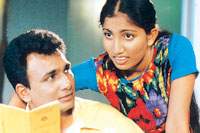| Plus |
|
|||
A chapter from the bheeshanaya era
Amaranath Jayatilaka is a serious student of cinema. In his own quiet way, he has tried to contribute towards the development of Sinhala cinema, both by educating local audiences by writing widely on the art of cinema and the intricacies of filmmaking and by trying his hand at making films which are different from the mass of meaningless productions over the past five decades. When I first met him in 1968, he had just finished his maiden film Adarawanthayo, which he described as an experiment, far from the ideal film he had in mind. After a few more films meant to provide light entertainment to cinema fans, he made Siripala Saha Ranmenika (1970) and Arunata Pera (1984) showing his talents as a serious filmmaker. In his latest creation, the tenth - Bheeshanaye Athuru Kathawak -- he takes us back to the reign of terror in the late '80s. Based on a novel by Nihal P. Jayatunga, Amaranath succeeds in presenting a gripping and sensitive tale, cinematically, without passing judgment. He gives the viewer ample clues to form his or her own opinion. The terror tactics by the offenders (whoever the party may be) are skilfully handled. The suspense is just right. The role of the investigative newspaper reporter, however, lacks conviction. Being responsible for the screenplay, production and direction of the film, Amaranath had his hands full. Delivering a quality product, he has handled the players well, though most of them are newcomers to the film world. For some of them, the experience on stage adds to their performance. Of the few seasoned artistes, Nita Fernando (the mother), Cletus Mendis (the new-rich mudalali who decides to give up his nefarious activities once he is threatened by the revolutionaries) and Visakha Siriwardena (his ambitious wife) portray their roles convincingly. Among the new players, Madhuranga Chandeemal (a professional in the banking sector) as the son/journalist, Anushka Ekanayake, toughman Akman's daughter and revolutionary leader Sarath Kotalawala perform well. It's good to know that there is plenty of talent around. So do Priyanjit Wijesekera who handles the music score while Lal Wickremarachchi has once again done a fine job with the camera-work. This film is yet another quality product done with loan facilities from the National Film Corporation (NFC). Son
of the soil As Madhubashini sees him, Kahandagamage's aim is to preserve a dialect and a way of life in the southeastern part of Sri Lanka which was once called Digamadulla. He wrote a number of novels as well as sketches from the forest with the backdrop of remote villages like Bintenna, Wawagampaththuwa, Panampaththuwa and Wellassa in the Moneragala and Ampara districts. Nevum Polova (The Fresh Earth), Vanvadule Vasanthaya (Spring in the Forest Glade) and Nimnayaka Andehere (The Call of a Valley) are his best known novels. He also wrote
the forest sketches, Vane Andunu Piya Satahan (Footsteps in the
Forest), Bintenne Viththi (Sketches from Bintenna) and Kohombane
Watte Vidane (The one in charge of the fields at Kohombana). His
non-fiction work Kethaka Mahima -- Kamatha received the State Literary
Award in 1992. |
||||
Copyright © 2001 Wijeya Newspapers
Ltd. All rights reserved. |
